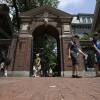At the top of Beacon Hill, directly across from the Statehouse, sits the Shaw Memorial by sculptor Augustus Saint-Gaudens. The memorial depicts Colonel Robert Gould Shaw leading his African American military unit—one of this country’s first— during the Civil War.
A new exhibition at the Massachusetts Historical Society is helping bring the stories and the mastery behind the monument to life. Free African-Americans enlisted in the Union Army in overwhelming numbers, eager to fight for the North in one of the of the first regiments of black troops formed during the Civil War. They were the "54th from Massachusetts," led by Colonel Robert Gould Shaw of a prominent Boston family of abolitionists. According to Massachusetts Historical Society Librarian Peter Drummey," in 1863, after the emancipation proclamation, the American Civil war became a war to end slavery. The people that were most committed to that had the most direct connection to that fight, were African Americans."
In July of 1863, under the cover of darkness, the 54th stormed Fort Wagner in South Carolina. The regiment was defeated with nearly half of the troops killed or wounded including Shaw. But that moment, the regiment’s ferocious battle for liberty would be memorialized—in remembrances, testimonials and even in Hollywood in the 1989 film "Glory."
Some 20 years after the battle, renowned sculptor Augustus Saint-Gaudens began work on the memorial that now defines the regiment. After 14 pain-staking years of work, his bronze monument was unveiled across from the Massachusetts Statehouse. It depicts Shaw leading his regiment south. Drummey shares: “I see real people when I look at the statue. They are not a type. They are not a group of faceless soldiers. They’re each individuals."
In Tell It With Pride, an exhibition created by the National Gallery of Art, and now at the Massachusetts Historical Society, we find the story stories behind the monument. For Saint-Gaudens, an internationally known artist, the sculpture was a labor of love. Anne Bentley, a Curator for the Massachusetts Historical Society describes "that was just the way he worked, his attention to detail, and his desire for accuracy, his gift for modeling. After the monument was unveiled he wasn’t terribly happy with it, and he continued to tinker for several years." It is a piece rich in detail—featuring the stoic and determined faces of 23 men marching off to battle. Guns hoisted, packs tugging and fabric folding. But they are not the real soldiers. Long after the war’s end, Saint-Gaudens hired some 40 models for inspiration.
To help put a face on the actual soldiers, Tell It With Pride introduces us to many of the regiment's real men—well represented in photographs they themselves commissioned. Says Drummey: "It's wonderful to see people who were proud of their uniforms and of their ranks as non commissioned officers... Often they paid to have the photograph hand colored. To bring out the gold of their buttons or their belt buckle or a different color at some parts of their uniform." The project also shares their letters, records and medals. Together, The Shaw Memorial, and the Tell It With Pride Exhibit help us more fully understand a small part of our history that has long been ignored.





